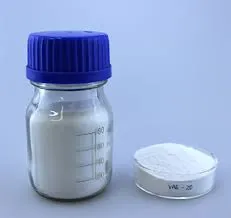
Dec . 17, 2024 21:17 Back to list
hypromellose hpmc
Understanding Hypromellose (HPMC) Properties and Applications
Hypromellose, also known as hydroxypropyl methylcellulose (HPMC), is a semi-synthetic polymer that has garnered significant attention in various industries due to its versatile properties and applications. A derivative of cellulose, HPMC is widely used in the pharmaceutical, food, cosmetic, and construction industries, owing to its unique characteristics such as non-toxicity, excellent film-forming ability, and water-solubility.
Chemical Structure and Properties
Hypromellose is derived from cellulose, which is the natural polymer found in the walls of plant cells. It is produced by treating cellulose with propylene oxide and methyl chloride. The degree of substitution varies, leading to a range of HPMC products with different solubilities and viscosities, making it suitable for diverse applications.
One of the most notable properties of HPMC is its ability to form viscous solutions when dissolved in water. This property is dependent on the concentration and the degree of substitution of the polymer. HPMC solutions are generally stable over a wide pH range, making them suitable for various formulations. Additionally, HPMC is non-ionic, which means it does not react with other ionic components in a solution, further enhancing its utility in complex formulations.
Applications in Pharmaceuticals
In the pharmaceutical industry, HPMC is predominantly used as a drug excipient. It serves multiple roles, including acting as a binder in tablet formulations, a coating agent, and a thickening agent in suspensions and emulsions. Its film-forming properties allow for the creation of controlled-release drug formulations, enhancing the therapeutic efficacy and bioavailability of active pharmaceutical ingredients (APIs). HPMC-based products are particularly beneficial for those requiring sustained-release medication, providing a steady release of the active ingredient over an extended period.
Moreover, HPMC is used in ophthalmic preparations due to its ability to retain moisture, making it an effective lubricant for dry eyes. Its biocompatibility and lack of irritability further endorse its usage in sensitive applications, enhancing patient comfort.
Role in the Food Industry
hypromellose hpmc

In the food industry, HPMC is utilized as a thickening, stabilizing, and emulsifying agent. Its capacity to retain water enhances the texture, stability, and shelf-life of various food products. It can be found in applications ranging from low-fat dairy products and sauces to gluten-free baked goods, where it helps in mimicking the texture typically provided by gluten.
HPMC is also recognized for its potential to replace high-calorie ingredients, making it an attractive option for health-conscious consumers. Its ability to form gels and foams adds texture and allows for the incorporation of air into various food products, improving mouthfeel.
Cosmetic and Personal Care Applications
In the cosmetics and personal care industry, HPMC is valued for its thickening and film-forming properties. It is used in a range of products, including lotions, creams, and hair styling gels. HPMC enhances the product’s texture and stability while providing a smooth application. Additionally, it can improve the sensory properties of formulations, making them more appealing to consumers.
Construction and Building Materials
Another important application of HPMC is in the construction industry, where it is used as a thickener and water-retaining agent in cement and tile adhesives. The incorporation of HPMC into these materials enhances consistency and workability, resulting in improved adhesion and durability of the finished product. Its water-retaining ability also allows for extended working times, reducing the risk of cracking and shrinkage.
Conclusion
Hypromellose (HPMC) is a multifunctional compound with a broad spectrum of applications across various industries. Its unique properties—ranging from excellent solubility and viscosity to biocompatibility—make it an indispensable ingredient in pharmaceuticals, food products, cosmetics, and construction materials. As research continues to uncover new applications and benefits of HPMC, its role in enhancing product performance and consumer satisfaction remains paramount. As industries strive for innovation and improvement, hypromellose will undoubtedly play a significant role in shaping future formulations and products.
-
Versatile Hpmc Uses in Different Industries
NewsJun.19,2025
-
Redispersible Powder's Role in Enhancing Durability of Construction Products
NewsJun.19,2025
-
Hydroxyethyl Cellulose Applications Driving Green Industrial Processes
NewsJun.19,2025
-
Exploring Different Redispersible Polymer Powder
NewsJun.19,2025
-
Choosing the Right Mortar Bonding Agent
NewsJun.19,2025
-
Applications and Significance of China Hpmc in Modern Industries
NewsJun.19,2025







